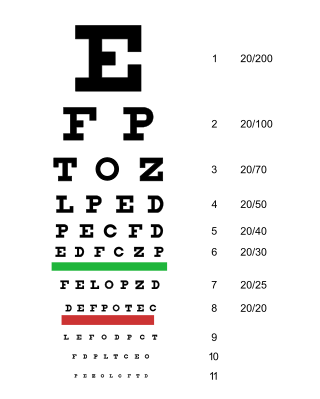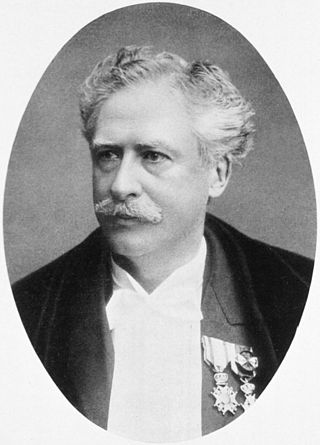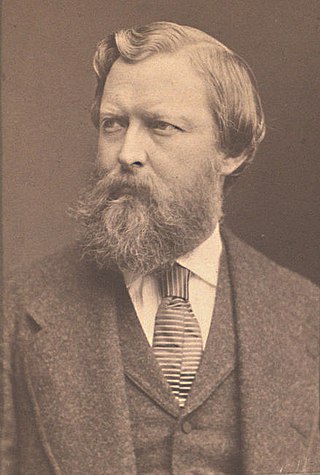
Allvar Gullstrand was a Swedish ophthalmologist and optician.

A Snellen chart is an eye chart that can be used to measure visual acuity. Snellen charts are named after the Dutch ophthalmologist Herman Snellen who developed the chart in 1862 as a measurement tool for the acuity formula developed by his professor Franciscus Cornelius Donders. Many ophthalmologists and vision scientists now use an improved chart known as the LogMAR chart.

An eye chart is a chart used to measure visual acuity comprising lines of optotypes in ranges of sizes. Optotypes are the letters or symbols shown on an eye chart. Eye charts are often used by health care professionals, such as optometrists, physicians and nurses, to screen persons for vision impairment. Ophthalmologists, physicians who specialize in the eye, also use eye charts to monitor the visual acuity of their patients in response to various therapies such as medications or surgery.

Herman Snellen was a Dutch ophthalmologist who introduced the Snellen chart to study visual acuity (1862). He took over directorship of the Netherlands Hospital for Eye Patients, after Franciscus Donders.

Johann Friedrich Horner was an ophthalmologist based at the University of Zurich, Switzerland.

Carl Wedl was a pathologist who was a native of Vienna, Austrian Empire.
Alfred Carl Graefe was a German ophthalmologist born in Martinskirchen.

Otto Heinrich Enoch Becker was a German ophthalmologist born near Ratzeburgin the Duchy of Holstein.

Christoph Friedrich Jäger Ritter von Jaxtthal was an Austrian ophthalmologist who was a native of Kirchberg an der Jagst.

August von Rothmund was a German ophthalmologist from Volkach, Lower Franconia.

Ernst Adolf Coccius was a German ophthalmologist who was a native of Knauthain, which today is part of the city of Leipzig.

Christian Georg Theodor Ruete was a German ophthalmologist born in Scharmbeck, Lower Saxony.

August Leopold von Reuss was an Austrian ophthalmologist. He was born in Bilin, Bohemia, and died in Vienna. He was the son of the geologist August Emanuel von Reuss (1811-1873), and father to the pediatrician August Reuss (1879-1954).

Ludwig Mauthner was an Austrian neuroanatomist and ophthalmologist who was a native of Prague.
Karl Stellwag von Carion was an Austrian ophthalmologist who was a native of Langendorf, a village in Moravia.

Louis de Wecker was a French ophthalmologist born in Frankfurt am Main, Germany.
August Emil Ludwig Wagenmann was a German ophthalmologist.
Hugo Magnus was a German ophthalmologist and historian of medicine. He was of Jewish ancestry.
Heinrich Schiess-Gemuseus, name sometimes given as Heinrich Schiess was a Swiss ophthalmologist.
Maximilian Salzmann was an Austrian ophthalmologist.













